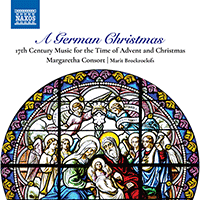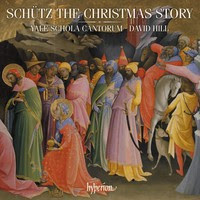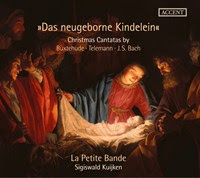Program: #19-51 Air Date: Dec 09, 2019
To listen to this show, you must first LOG IN. If you have already logged in, but you are still seeing this message, please SUBSCRIBE or UPGRADE your subscriber level today.
The Margaretha Consort with a German Christmas, Schutz’s Christmas Story with the Yale Schola Cantorum, and cantata by Buxtehude and Telemann.
I. A German Christmas: 17th Century Music for the Time of Advent and Christmas (Margaretha Consort/Marit Broekroelofs). Naxos CD 8.551398.

In the 17th century the organist was an integral part of musical life. Amongst the supporting role of the organ in accompanying instrumentalists and singers, the instrument also approached very closely the sound ideal of the time: the impassive and unmoving organ tone expressed exactly the non-temporality, the supra-personal that were alive in the baroque era. The organist as ‘kappelmeister’ supported the choir and congregational singing. However, gradually there started to be a greater focus on the organ as a solo instrument and repertoire began to be composed for the beginning and ending of services and occasionally for other moments during the liturgy. In the time of the reformation, the leading theologians were not very happy with these developments. Johannes Calvin (1509–1564) for example was not in favour of polyphonic singing and the use of organ in the church service. Fortunately Martin Luther (1483–1546) had other thoughts on the topic. He said that the gospel should be heard in both text and music. Thus in the Lutheran tradition there has always been room for congregation singing, mixed voiced choirs and organ music (with choral arrangements).
Singing as a congregation was at that time not yet standard practice. Until this moment, music in the church was only performed by the church clerics and choir. Luther started a new tradition and wrote hymns that could be sung by the congregation. He translated Latin songs into German and even wrote new texts all together! He was convinced that the church hymn was the most effective way to proclaim and spread God’s Word. “A song is praise, catechism, prayer and sermon all together”, he said. The new German hymns were to be sung in the home and during church worship. This subsequently inspired composers to write vocal and instrumental arrangements on these new hymns. Composers like Michael Praetorius, Heinrich Schütz, Hans Leo Hassler, Johann Ulrich Steigleder, Jacob Praetorius and many more developed this into a whole new tradition. These musicians proved themselves important Lutheran composers of the 17th century in the field of church music and have subsequently left the church and the whole mankind a fantastic legacy. Many of these carols are still sung today especially during Advent and Christmas.
The pieces on this album originate largely from the Christmette by Michael Praetorius. In addition, nativity hymns by a range of different composers from the same era have been compiled. In Lutheran style the compositions on this album include solo- pieces, choir arrangements, double-choral motets, instrumental pieces and of course the church organ repertoire. The listener can also hear pieces, which were not necessarily meant for Christmas, but fit the program very well. The function of some of the pieces is liturgical, like “Gloria” (9), “Our Father” (11) or the mighty Entrance-Prelude (1). Two other pieces are meditative moments about the name of Jesus (3, 7).
Many of the songs are well-known. However, the arrangements for soloists and/ or choir from Praetorius and his contemporaries are rarely performed. In addition, no two performances of this music sound the same. This is due to the musician of the 17th century having great freedom in choices of ensemble specification, tempo and ornamentation. On this note the Margaretha Consort has made choices that will differ from another ensemble. We have, for example, chosen one vocal and one instrumental “choir” in a double-choral motet (“In dulci jubilo”), put an instrumental choir with one vocal soloist and a vocal choir with one instrumental soloist (“Nun komm der Heiden Heiland”) and the beautiful “Puer natus” has been arranged for three solo sopranos instead of two. All these things make this early music sound as new and fresh as if written yesterday.
Besides the familiar pieces, there are some less well-known ones on this album. Little gems such as „Nobilissime Jesu“ and „Illibata ter beata“ appear which were never published and thus hardly ever performed. In addition the hymn „Allein Gott in der Höh sei Ehr“ written by composer Michael Praetorius has also remained quite unknown in this six-voiced version.
This album has been recorded in the Oude Helena Church in Aalten (the Netherlands), a spacious pseudo basilica style building with generous acoustics. By carefully positioning two miniature microphones, by preventing the so-called short reflections and by allowing the walls and vaults to do the work, this 17th century music, which varies from being extremely intimate to completely overwhelming, shows its true character to the listeners and gives them the experience of being in the church itself.
Marit Broekroelofs
1. Praeludium - F. Tunder
2. Nun komm der Heiden Heiland - Gregorian/Praetorius/Anon
3. O Jesu, nomen dulce - Schutz
4. In dulci jubilo - Praetorious/Gesius
5. Maria durch ein Dornwald ging - Trad/Wakelkamp
6. Puer natus in Bethlehem - Praetorius/Siefert
7. Nobilissime Jesu - Mazak
8. Heute ist Christus der Herr geboren - Schutz
9. Allein Gott in der Hoh sei Ehr - Praetorius
10. Illibata ter beata - Hurtado
11. Vater unser - Hassler/Steigleder/Praetorius
12. Quem Pastores - Praetorius
13. Es ist ein Ros entsprungen - Praetorius
14. Wie schon leuchtet der Morgenstern - Schein/Praetorius
15. Vom Himmel hoch - Schiedemann/Hassler
16. Ven ven Emmanuel - Wakelkamp
II. Schütz: The Christmas Story (Yale Schola Cantorum/David Hill). Hyperion CD CDA68315.

Schütz’s place in the musical pantheon was saved by the timely intervention of a princely patron, who sent him to Venice to study with Giovanni Gabrieli in 1609. Although he returned to Germany more determined than ever to become a composer, in deference to his parents’ wishes he “was about to seek out my books which I had previously laid aside when God Almighty (who no doubt had singled me out in the womb for the profession of music) ordained that in 1614 I be called to serve in Dresden” to compose music for a royal christening. Three years later, he accepted the position of de facto Kapellmeister to Elector Johann Georg I.
Schütz apparently saw no conflict between his artistic allegiance to Catholic Italy, which he called “the true university of music,” and his staunch Protestant faith. Apart from an early collection of madrigals composed in the first flush of his discovery of the extroverted, melodically rich Italian style, virtually all his surviving music was written either for the Lutheran Church or for religious ceremonies such as weddings, funerals, and christenings. Today’s program juxtaposes two large-scale works—a lavishly scored narrative of the birth of Christ and a monumental Magnificat—with an assortment of shorter vocal pieces set to both German and Latin texts.
Historia der Geburt Jesu Christi, SWV 435
A quasi-dramatic retelling of the Nativity story, Schütz’s Christmas History (as it’s usually called in English) was designed to be performed as part of the vesper service in Dresden on Christmas Day. “The birth of Christ in recitative style” was the court diarist’s laconic description in an entry dated December 25, 1660. Schütz’s use of Italian-style operatic recitative for the Evangelist’s narration marked a departure from the chant-like recitation that had characterized his Resurrection History of 1623. The composer took pains to highlight this avant-garde feature of the Christmas History; when the score was partially published in 1664, he boasted that he had introduced a “new manner of composition which, as far as is known, has never hitherto appeared in print in Germany.” The influence of Gabrieli and Monteverdi, whom Schütz met on a second trip to Italy in the late 1620s, can also be heard in the work’s Italianate vocal lines and occasional flights of operatic coloratura.
Structurally, the Christmas History consists of eight tableaux, or “intermedia,” for solo voices and/or chorus with instrumental accompaniment, alternating with sparer continuo recitatives for the tenor Evangelist. Elector Johann Georg II, who commissioned the work, maintained a chapel of some fifty singers and instrumentalists, and Schütz deployed it to full advantage: his score calls for no fewer than twelve voices and a large orchestra of strings (modern violins and violas, as well as members of the older-fashioned viol family), recorders, trombones, trumpets, bassoon, and organ. In keeping with traditional associations, the shepherds are accompanied by “pastoral” recorders, the angel by ethereal violettas (treble viols), King Herod by “regal” trumpets (or cornetts), and the high priests by mellow trombones. The popular appeal of the Christmas History is enhanced by such artful effects as the repeating two-note bass figure in the angel’s three intermedia, which according to Schütz depicts the “rocking of the Christ child’s cradle.”
Hodie Christus natus est, SWV 456
This joyful celebration of the Nativity was probably composed for a Christmas Day vesper service at Dresden during the 1640s. Schütz’s sonorous six-voice choir (two sopranos, alto, two tenors, and bass) harks back to Gabrieli’s ten-part Hodie Christus natus est of 1597. The pacing and meter of the music are skillfully varied: lively triple-time “Alleluia” refrains alternate with phrases of the familiar liturgical text laid out in four-square rhythms. Schütz is equally attentive to textural variety, as illustrated by the imitative duet for alto and tenor on “Hodie Salvator apparuit” and the stately, antiphonal “Gloria” for two three-voice choirs.
Ave Maria, SWV 334
Schütz published his second set of Kleine geistliche Konzerte in 1639. Among the thirty-two “little sacred concertos” in the collection is this charming Latin-texted Ave Maria for five voices, five instruments, and continuo. The Annunciation story is presented as an intimate conversation between the angel Gabriel and Mary in recitative-like monodic style, known as stilo rappresentativo to the forward-looking composers Schütz had met in Italy. Only once do the solo voices overlap, when Mary impatiently interrupts the angel’s longwinded speech. Their dialogue is sandwiched between short instrumental “symphonies,” and the work ends with a spirited chorus for concerted voices and instruments.
Der Engel sprach, SWV 395
Voices and instruments are also combined to splendid effect in Schütz’s adaptation of a Christmas motet by Andrea Gabrieli titled Angelus ad pastores ait (The angel spoke to the shepherds). The intricately wrought seven-voice counterpoint and smoothly flowing imitative textures demonstrate his mastery of the slightly old-fashioned polyphonic idiom associated with Giovanni Gabrieli, Orlande de Lassus, and other late Renaissance composers. In retrofitting the elder Gabrieli’s music to German words, Schütz hoped to convince his compatriots that the vocal counterpoint they admired in their Italian models could be successfully emulated, a topic that was hotly debated in Germany in the 1640s.
Ein Kind ist uns geboren, SWV 384
Like Der Engel sprach and Das Wort ward Fleisch, Ein Kind ist uns geboren (Unto us a child is born) first appeared in Schütz’s Geistliche Chor-music (Spiritual Choral Music), an anthology of German motets published in 1648, the year the Peace of Westphalia brought an end to the ruinous Thirty Years’ War. In his preface, Schütz urged other German composers who had embraced the fashionable “Italian style of composition with basso continuo” not to neglect the older art of purely vocal polyphony. By way of example, he dispensed with a continuo accompaniment in this richly textured six-voice setting of the prophecy of the Messiah’s coming. Treating the upper and lower voices as distinct choirs, Schütz carefully calibrates the music’s pulse to the lengths and stresses of the German language.
Das Wort ward Fleisch, SWV 385
Another short six-voice motet without continuo, Das Wort ward Fleisch (The Word became flesh) is even more vividly expressive in its text-setting than Ein Kind ist uns geboren. The opening phrase, with its sustained notes and intense harmonies building to a resplendent E-major cadence, dramatically depicts the incarnation of God’s son. In the second phrase (“unt wohnet unter uns”), Schütz uses shorter note values and livelier rhythms to suggest Christ’s presence on earth in human form. A host of other subtle touches, such as the rising-scale figure that repeatedly underlines the word “Herrlichkeit” (majesty), constitute a kind of musical commentary on the verses from the Gospel of John.
Magnificat, SWV 468
Schütz’s Magnificat was probably composed around the same time as the Christmas History and is scored with similar opulence: four soloists (the so-called coro favorito, or select choir) are combined with two four-voice choruses, two violins, three trombones, and continuo. Divided into short, clearly defined sections that correspond to segments of the Latin text, the music illustrates Schütz’s ingenuity at matching the words to sundry combinations of voices and instruments. In the brightly declamatory opening chorus, for example, the solo tenor calls out each phrase in advance of the other singers. This section leads, somewhat unexpectedly, to a wordless trombone trio in imitative counterpoint, followed by a light-textured duet for soprano and tenor with continuo accompaniment (“Et exultavit”) and a brief dialogue between the solo bass and violins (“Quia respexit”). The bass’s sturdily triadic melody morphs into the nimbly overlapping choral phrases of “Ecce, ecce enim,” which in turn flower into the full-throated sonorities of “omnes generationes.”
A few bars later, Schütz treats us to a classic example of Baroque word-painting in the fast flurry of sibilants that erupts on the words “dispersit superbos” (He hath scattered the proud). The contrast between this animated outburst and the strenuously falling and rising lines of the ensuing section, “Deposuit potentes … et exaltavit humiles” (He hath put down the mighty … and exalted the humble), could hardly be more dramatically apposite. Elsewhere in the Magnificat, the antiphonal effects created by the interplay between the two choirs evoke the sumptuous polychoral music that Schütz’s teacher, Gabrieli, composed for St. Mark’s Cathedral in Venice. As the work approaches its majestic climax, Schütz marshals all his forces for the “Gloria,” and his stirring canticle of praise ends with a setting of the text “Sicut erat in principio” that neatly recalls the music “as it was in the beginning.”
Wann unsre Augen schlafen ein, SWV 316
Like Ave Maria, this short concerto was published in the second volume of Kleine geistliche Konzerte. Schütz’s simple chorale setting for soprano, bass, and continuo reflects the straitened circumstances of the Dresden chapel during the final phase of the Thirty Years’ War. “Praiseworthy music,” the composer lamented, “has not only fallen into great decline through the constant perils of war … but in many places has ceased altogether, suffering the general ruin and disorder which invariably results from unholy strife.” The lugubriously descending chromatic lines of Wann unsre Augen schlafen ein (When our eyes droop in sleep) contrast with rippling passagework depicting the vigilance of the unsleeping heart.
Notes © by Harry Haskell
Historia der Geburt Jesu Christ, SWV 435
Hodie Christus natus est, SWV 456
Ave Maria, SWV 334
Der Engel Sprach, SWV 395
Ein kind ist uns geboren, SWV 384
Das Wort ward Fleisch, SWV 385
III. Das neugeborne Kindelein: Christmas Cantatas by Buxtehude, Telemann, Bach (La Petite Band/Sigiswald Kuijken). Accent CD ACC 24348.

Telemann’s 1720 Missa sopra “Ein Kindelein so löbelich” uses the tune as a cantus firmus. Over this foundation Telemann weaves four-part counterpoint that pays homage to Palestrina and other late-Renaissance masters. His other cantata, O Jesu Christ, Dein Kripplein ist mein Paradie was written 18 years later. Here the form follows the then-standard alternation between solo aria and chorale.
That’s also true of Bach’s Ich freue mich in dir, which is at the center of the program. The difference is style. Telemann’s late cantata is written in more of an Italian style, and has a lightness to it. Bach’s cantata, though only using four singers, seems weightier. The harmonies sound thicker, and of course, the counterpoint more complex.
La Petite Bande and Sigiswald Kuijken are past masters of this repertoire. They adjust their performances to match the composers’ style, further highlighting the differences between the three. If you’re looking for a great example of German Baroque Christmas music, I strongly recommend “Das neugeborne Kindelein.”
J.S. Bach (1685 -1750): “Süsser Trost, mein Jesus kömmt” (Cantate BWV 151, composed 1725)
G.Ph. Telemann (1681 – 1767) : “O Jesu Christ, dein Kripplein ist” (1748)
G.Ph. Telemann : Missa (brevis) on the Christmas song “Ein Kindelein so löbelich” (1735)
J.S. Bach : “Ich freue mich in dir” ( from 1724 – BWV 133)
Dietrich Buxtehude : “Das neugeborne Kindelein”
Composer Info
Tunder, Praetorius, Schutz, Gesius, Wakelkamp, Siefert, Mazak, Hurtado, Hassler, Steigleder, Schein, Schiedemann, Dietrich Buxtehude (1637-1707), Johann Sebastian Bach (1685-1750), Georg Philipp Telemann (1681-1767)
CD Info
Naxos CD 8.551398, Hyperion CD CDA68315, Accent CD ACC 24348